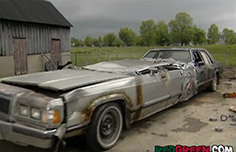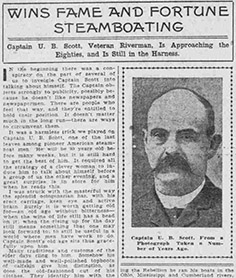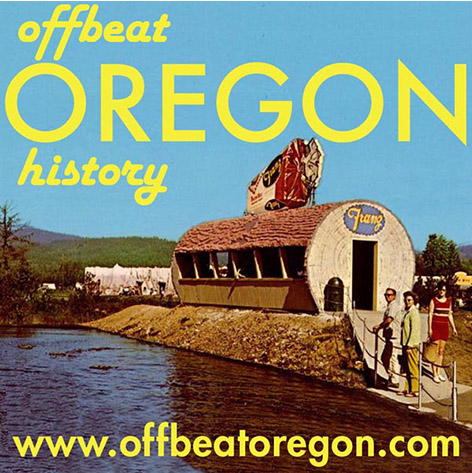CANEMAH, CLACKAMAS COUNTY; 1870s:
They laughed at Captain Scott’s ugly boat...at first
By Finn J.D. John
|

The other riverboat company was the People’s Transportation Co., which, as its populist-sounding name suggests, was originally a scrappy upstart steamboat line created to challenge Oregon Steam Navigation Co., and tap into the frustration of the traveling and freight-shipping public. But after a few successful years, it lost that competitive fire and made a cozy deal with OSN, which basically gave each company a monopoly on one of the two rivers — People’s on the Willamette, and OSN on the Columbia. With this arrangement in place, People’s had settled in as a sort of junior monopoly, and both companies worked to avoid any profit-killing competition in their routes. Thus, neither one of them had much of an interest in improvements to their service unless they wouldn’t cost money to implement. But building new boats would, of course, cost quite a bit of money, without adding much if any revenue — as things were, they still were able to charge farmers to transport their crops, just later in the year than they would have liked. It was a classic example of a market ripe for disruption, in which the disruptive innovation would have to come from outside. The established players weren’t interested. 
Capt. Uriah B. Scott’s second steamboat, the City of Salem, takes on passengers at a dock somewhere near Salem, probably sometime in the 1880s. The image is marked as copyright 1920, but that is probably the date this print was made; the City of Salem was no longer in service at that time. Capt. Scott liked to boast that the City of Salem could run on “a heavy dew.” (Photo: Salem Public Library)Willamette Valley farmers, though, were very interested indeed. Above Harrisburg or so, People’s Transportation Co. steamboats couldn’t get far enough up the river to pick up anyone’s crops until deep into the rainy season, when the river levels were quite high. By that time, unless the grain was very carefully stored, the valley’s famous fogs had probably soaked it and opened the door for molds and mildews to ruin it. There was definitely a market for the boats Scott was talking about, and Scott knew it well. A week after the Ohio was launched, everyone else in Portland knew it too.
But into the river it went, and it floated like a water skipper. The watching riverboat men wondered aloud if the old dredge engine was powerful enough to allow it to make headway against the current. Scott rang for steam and left the dock; soon it was out of sight. It made way very nicely, too, floating level in the water and gliding through it smoothly and rapidly. You have to wonder if the other steamboat men started having second thoughts at this point. Could it be that this ignoramus from back east actually knew what he was doing? They got their answer a week or so later, when the Ohio got back from its run and they heard about its journey. It had made it all the way to Eugene City without so much as scraping bottom, taken on 70 tons of wheat, and steamed uneventfully back. Now it was ready to go and do it again. The secret of the Ohio’s success was that wide, flat, ugly hull. It could float on nine inches of water when it was empty, and with 100 tons of wheat on board, 18 inches. There are stories of boys out wading in the river having to be shooed out of the way so the ugly little steamboat could get through. The other steamboat men considered their designs shallow-draft, but they were water hogs compared with the Ohio. No other boat on the river could get within 40 miles of Eugene City even empty, to say nothing of getting back downstream with cargo. Oh, it hadn’t all been roses. The boat really was very janky. Several times the gas-pipe pitman arms had bent, locking the paddlewheel and forcing a laborious fix that probably involved a blacksmith’s hammer. Scott also found that the homemade paddlewheel had a tendency to work loose and separate from the boat. When this happened, they had to launch the boat’s tender and row after it, put a line on it, and laboriously tow it back to the wallowing Ohio to be re-mounted. It was tedious, and the boatswain didn’t always appreciate the exercise. But by the end of the freight season, Scott had made enough money to pay off his investors with enough left over to build a better boat — which he did, and that was the City of Salem. The City of Salem was larger, far superior in build quality, and drew even less water than the Ohio — Scott liked to say that it could run on a heavy dew. But it does kind of go without saying that, if Scott had felt the need to raise any more capital from investors to build it, he would have had all he could possibly need!
Of course, they tried to buy Scott out. It must have been rather satisfying for Scott to have the same guys who’d blown him off when he asked for a job, and laughed him off when he was building the Ohio, now coming to him with hats in hands. But the time for that sort of thing was long past, and Scott was now in a position to raise all the capital he’d ever need. A third steamboat company had been born, and as Red Green would no doubt remark, its proprietor could certainly be depended upon to “keep his stick on the ice.” But the upper Willamette wouldn't be a profitable zone for long — not with railroads on the way. Soon Captain Scott found himself having to look farther downstream for profitable places to operate. He started with the Portland to The Dalles run — and when he did, he crossed swords with the mighty Oregon Railway & Navigation Company. Guess who won! Or, better yet, read all about it in this Offbeat Oregon article about it.
|




